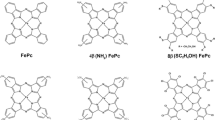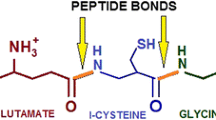Abstract
In this work we have tested the Fe(III)/(II) redox potential of the catalysts as a reactivity descriptors of iron macrocyclic complexes (FeN4) adsorbed on multi-walled carbon nanotubes (MWCNTs) and deposited on ordinary pyrolytic graphite (OPG). The reaction examined is the oxidation of glutathione (GSH) a biologically important molecule. The experiments were conducted in 0.1 M NaOH and kinetic measurements were performed on MWCNT previously modified with FeN4 macrocycle complexes. This modified FeN4–MWCNTs were deposited on pristine OPG electrodes. From previous work it is known that for FeN4 complexes directly adsorbed on OPG, the activity as (log i)E plotted versus the Fe(II)/(I) redox potential follows a volcano correlation for the oxidation of glutathione. We wanted to test these correlations on hybrid electrodes containing MWCNTs and essentially the carbon nanotubes have no influence in these correlations and the redox potentials a are good reactivity descriptors, regardless of the way the FeN4 catalysts are attached to the electrode. Further, we find volcano correlations when using the Fe(II)/(I) and the Fe(III)/(II) redox potentials as reactivity descriptors. The volcano correlation when using the Fe(III)/(II) redox potential exhibits a maximum at E° = –0.26 V vs SCE which is close to the potential for comparing the different activities. This interesting result seems to indicate that the maximum cannot be explained only in terms of the Sabatier principle where θRS, the surface coverage of adsorbed intermediate is close to 0.5 but instead to a surface coverage of active sites θFe(II) equal to 0.5, which occurs at the Fe(III)/(II) formal potential.




Similar content being viewed by others
REFERENCES
Meister, A., Glutathione metabolism and its selective modification, J. Biol. Chem., 1988, vol. 263, p. 17205.
Meister, A. and Anderson, M.E., Glutathione, Annu. Rev. Biochem., 1983, vol. 52, p. 711. https://doi.org/10.1146/annurev.bi.54.070183.003431
Ziegler, D.M., Role of reversible oxidation-reduction of enzyme thiols-disulfides in metabolic regulation, Annu. Rev. Biochem., 1985, vol. 54, p. 305. https://doi.org/10.1146/annurev.bi.54.070185.001513
Sehlotho, N., Nyokong, T., Zagal, J.H., and Bedioui, F., Electrocatalysis of oxidation of 2-mercaptoethanol, l‑cysteine and reduced glutathione by adsorbed and electrodeposited cobalt tetra phenoxypyrrole and tetra ethoxythiophene substituted phthalocyanines, Electrochim. Acta, 2006, vol. 51, p. 5125. https://doi.org/10.1016/j.electacta.2006.03.049
Masella, R. and Mazza, G., Glutathione and Sulfur Amino Acids in Human Health and Disease, New York: Wiley, 2009. https://doi.org/10.1002/9780470475973
Chakravarthi, S., Jessop, C.E., and Bulleid, N.J., The role of glutathione in disulphide bond formation and endoplasmic-reticulum generated oxidative stress, EMBO Rep., 2006, vol. 7, p. 271. https://doi.org/10.1038/sj.embor.7400645
Tummanapelli, A.K. and Vasudevan, S., An initio MD simulation of the Brönsted acidity of glutathione in aqueous solutions: predicting pKa shifts of the cysteine residue, J. Phys. Chem. B, 2015, vol. 119, p. 15353. https://doi.org/10.1021/acs.jpcb.5b10093
Gutierrez, C., Paez, M., and Zagal, J.H., Reactivity descriptors for iron porphyrins and iron phthalocyanines as catalysts for the electrooxidation of reduced glutathione, J. Solid State Electrochem., 2016, vol. 20, p. 3199. https://doi.org/10.1007/s10008-016-3396-z
Zagal, J.H., Aguirre, M.J., and Parodi, C.G., Electrocatalytic activity of vitamin B12 adsorbed on graphite electrode for the oxidation of cysteine and glutathione and the reduction of cystine, J. Electroanal. Chem., 1994, vol. 374, p. 215.
Sekhosana, K.E., Antunes, E., Khene, S., D’Souza, S., and Nyokong, T., Fluorescence behavior of glutathione capped CdTe@ZnS quantum dots chemically coordinated to zinc octacarboxy phthalocyanines. J. Lumin., 2013, vol. 136, p. 255. https://doi.org/10.1016/j.poly.2011.10.024
Porras Gutierrez, A., Rangel Argote, M., Griveau, S., Zagal, J.H., Gutierrez-Granados, S., Alatorre Ordaz, A., and Bedioui, F., Catalytic activity of electrode materials based on polypyrrole, multi-wall carbon nanotubes and Cobal phthalocyanine for the electrooxidation of glutathione and L-cysteine, J. Chilean Chem. Soc., 2012, vol. 57, p. 1244. https://doi.org/10.4067/S0717-97072012000300010
Tang, H., Chen, J., Nie, J., Yao, S., and Kuang, Y., Electrochemical oxidation of glutathione at well-aligned carbon nanotube array electrode, Electrochim. Acta, 2006, vol. 51, p. 3046. https://doi.org/10.1016/j.electacta.2005.08.038
Safavi, A., Maleki, N., Farjami, E., and Mahyari, F.A., Simultaneous electrochemical determination of glutathione and glutathione disulfide at a nanoscale copper hydroxide composite carbon ionic liquid electrode, Anal. Chem., 2009, vol. 81, p. 7538. https://doi.org/10.1021/ac900501j
Pereira-Rodrigues, N., Cofre, R., Zagal, J.H., and Bedioui, F., Electrocatalytic activity of CoPc adsorbed on graphite electrode for the oxidation of glutathione (GSH) and the reduction of its disulfide (GSSG) at physiological pH, Bioelectrochemistry, 2007, vol. 70, p. 147. https://doi.org/10.1016/j.bioelechem.2006.03.025
Sehlotho, N., Nyokong, T., Zagal, J.H., and Bedioui, F., Electrocatalysis of oxidation of 2-mercaptoethanol, L‑cysteine and reduced glutathione by adsorbed and electro-deposited cobalt pyrrole-phenoxy and ethoxy-thiophene substituted phthalocyanines, Electrochim. Acta, 2006, vol. 51, p. 5125. https://doi.org/10.4067/S0717-97072012000300010
Griveau, S., Gulppi, M., Pavez, J., Zagal, J.H., and Bedioui, F., Cobalt phthalocyanine-based molecular materials for the electrocatalysis and electroanalysis of 2-mercaptoethanol, 2-mercaptoethanesulfonic acid, reduced glutathione and L-cysteine, Electroanalysis, 2003, vol. 15, p. 779. https://doi.org/10.1002/elan.200390096
Aguirre, M.J., Isaacs, M., Armijo, F., Bocchi, N., and Zagal, J.H., Catalytic electrooxidation of 2-mercaptoethanol on perchlorinated iron phthalocyanine adsorbed on graphite electrodes, Electroanalysis, 1998, vol. 10, p. 571. https://doi.org/10.1002/(SICI)1521-4109(199807)10:8<571::AID-ELAN571>3.0.CO;2-7
Zagal, J.H. and Paez, C., Catalytic electrooxidation of 2-mercaptoethanol on a graphite electrode modified with metal phthalocyanines, Electrochim. Acta, 1989, vol. 34, p. 243.
Lezna, R.O., Juanto, S., and Zagal, J.H., Spectrochemical studies on tetrasulfonated metallophthalocyanines adsorbed on the basal plane electrode in the presence of cysteine, J. Electroanal. Chem., 1998, vol. 452, p. 221. https://doi.org/10.1016/j.electacta.2013.07.230
Cárdenas-Jirón, G.I. and Zagal, J.H., Donor-acceptor intermolecular hardness on charge transfer reactions of substituted cobalt phthalocyanines, J. Electroanal Chem., 2001, vol. 497, p. 55. https://doi.org/10.1016/S0022-0728(00)00434-4
Zagal, J.H. and Páez, C., Catalytic electro-oxidation of 2-mercaptoethanol on a graphite electrode modified with metal phthalocyanines, Electrochim. Acta, 1989, vol. 34, p. 243. https://doi.org/10.1016/0013-4686(89)87092-6
Cárdenas, G.I., Caro, C.A., Venegas-Yazigi, D., and Zagal, J.H., Theoretical study of charge transfer energy profile of cobalt phthalocyanine and 2-mercaptoethanol. Effect of the graphite on the global reactivity. J. Molec. Struct. (Theochem.), 2002, vol. 580, p. 193. https://doi.org/10.1016/S0166-1280(01)00613-3
Aguirre, M.J., Isaacs, M., Armijo, F., Basáez, L., and Zagal, J.H., Effect of the substituents on the ligand of iron phthalocyanines adsorbed on a graphite electrode on their activity for the electrooxidation 2-mercaptoethanol, Electroanalysis, 2002, vol. 14, p. 356. https://doi.org/10.1002/1521-4109(200203)14:5<356::AID-ELAN356>3.0.CO;2-U
Gulppi, M.A., Recio, F.J., Tasca, F., Ochoa, G., Silva, J.F., Pavez, J., and Zagal, J.H., Optimizing the reactivity of surface confined cobalt N4-macrocyclics for the electrocatalytic oxidation of L-cysteine by tuning the Co(II)/(I) formal potential of the catalyst, Electrochim. Acta, 2014, vol. 126, p. 37. https://doi.org/10.1016/j.electacta.2013.07.230
Silva, N., Castro-Castillo, C., Oyarzún, M.P., Ramírez, S., Gutierrez-Ceron, C., Marco, J.F., Silva, J.F., and Zagal, J.H., Modulation of the electrocatalytic activity of Fe phthalocyanine to carbon nanotubes: electrochemistry of l-cysteine and l-cystine, Electrochim. Acta, 2019, vol. 308, p. 295.
Akkurst, F. and Hamuryudan, E., Enhancement of solubility via esterification: synthesis and characterization of octakis (ester)-substituted phthalocyanines, Dyes Pigments, 2008, vol. 79, p. 153. https://doi.org/10.1016/j.dyepig.2008.02.001
Bedioui, F., Griveau, S., Nyokong, T., Appleby, A.J., Caro, C.A., Gulppi, M., Ochoa, G., and Zagal, J.H., Tuning the redox properties of metalloporphyrin and metallophthalocyanine based molecular electrodes for the highest electrocatalytic activity for the oxidation of thiols, Phys. Chem. Chem. Phys., 2007, vol. 9, p. 3383. https://doi.org/10.1039/b618767f
Villagra, E., Bedioui, F., Nyokong, T., Canales, J.C., Páez, M.A., Costamagna, J., and Zagal, J.H., Tuning the redox properties of Co-N4 macrocyclic complexes for the catalytic electrooxidation of glucose, Electrochim. Acta, 2008, vol. 53, p. 4883. https://doi.org/10.1016/j.electacta.2008.02.006
Linares-Flores, C., Zagal, J.H., Pavez, J., Pino-Riffo, D., and Arratia-Pérez, R., Reinterpreting the role of the catalyst formal potential. The case of thiocyanate electrooxidation catalyzed by CoN4-macrocyclic complexes, J. Phys. Chem. C, 2012, vol. 116, p. 7091. https://doi.org/10.1021/jp300764n
Zagal, J.H., Cañete, P., Recio, J., Tasca, F., and Linares-Flores, C., Tuning the Fe(II)/(I) formal potential of FeN4 catalysts adsorbed on graphite electrodes to the reversible potential of the reaction for maximum activity: hydrazine oxidation, Electrochem. Comm., 2013, vol. 30, p. 34. https://doi.org/10.1016/j.elecom.2013.01.024
Silva, N., Castro-Castillo, C., Oyarzún, M.P., Ramírez, S., Gutierrez-Ceron, C., Marco, F.J., Silva, J.F., and Zagal, J.H., Modulation of the electrocatalytic activity of Fe phthalocyanine to carbon nanotubes: electrochemistry of l-cysteine and l-cystine, Electrochim. Acta, 2019, vol. 308, p. 295. https://doi.org/10.1016/j.electacta.2019.04.005
Silva, N., Calderón, S., Páez, M.A., Oyarzún, M.P., Koper, M.T.M., and Zagal, J.H., Probing the Fen+/Fe(n – 1)+ redox potential of Fe phthalocyanines as a reactivity descriptor in the electrochemical oxidation of cysteamine, J. Electroanal. Chem., 2018, vol. 15, p. 502. https://doi.org/10.1016/j.jelechem.2017.12.068
Zagal, J.H. and Koper, M.K.T., Reactivity descriptors for the activity of MN4 molecular catalysts for the oxygen reduction reaction, Angew. Chem., 2016, vol. 55, p. 14510. https://doi.org/10.1002/anie.201604311
Linares, C., Geraldo, D., Paez, M., and Zagal, J.H., Non-linear correlations between the formal potential and Hammett parameters of substituted iron phthalocyanines and catalytic activity for the electrooxidation of hydrazine, J. Sol. State Electrochem., 2003, vol. 7, p. 626.
Shumba, M. and Nyokong, T., Effects of covalent versus non-covalent interactions on the electrocatalytic behavior of tetracarboxyphenoxyphthalocyanine in the presence of multi-walled carbon nanotubes, J. Coord. Chem., 2017, vol. 70, p. 1585. https://doi.org/10.1080/00958972.2017.1303679
O’Donoghue, C.S.J.N., Shumba, M., and Nyokong, T., Electrode modification through click chemistry using Ni and Co alkyne phthalocyanines for electrocatalytic detection of hydrazine, Electroanalysis, 2017, vol. 29, p. 1731. https://doi.org/10.1002/elan.201700084
Makinde, Z.O., Louzada, M., Mashazi, P., Nyokong, E.T., and Khene, S., Electrocatalytic behaviour of surface confined pentanethio cobalt(II) binuclear phthalocyanines towards the oxidation of 4-chlorophenol, Appl. Surf. Sci., 2017, vol. 425, p. 702. https://doi.org/10.1016/j.apsusc.2017.06.271
Ureta-Zañartu, M.S., Alarcon, A., Muñoz, G., and Gutierrez, C., Electrooxidation of methanol and ethylene glicol on gold and on gold modified with an electrodeposited polyNiTSPc film, Electrochim. Acta, 2007, vol. 52, p. 7857. https://doi.org/10.1016/j.electacta.2007.06.055
Kaczmarzyk, T., Jacokski, T., and Dzilinski, K., Spectroscopic characteristic of FeI-phthalocyanine, Nukleokina, 2007, vol. 52, p. S99.
Bletsa, E., Solakidou, M., Louloudi, M., and Deligianakis, Y., Oxidative catalytic evolution of redox and spin-states of a Fe-phthalocyanine studied by EPR, Chem. Phys Lett., 2016, vol. 649, p. 48.
Kobayashi, N., Shirai, H., and Hojo, N., Iron(III) phthalocyanines: oxidation and spin states of iron phthalocyanines with carboxyl groups, Dalton Trans., 1984, vol. 10, p. 2107.
Funding
The authors are grateful to Fondecyt Projects 1140199, 1181037, Nucleo Milenio RC 120001 and Dicyt-Usach Postdoctoral Fellowship to C. G-C.
Author information
Authors and Affiliations
Corresponding authors
Ethics declarations
The authors declare that they have no conflict of interest.
Additional information
This paper is dedicated to the 80th anniversary of Professor V.V. Malev who has made a considerable contribution into modern directions of electrochemistry.
Rights and permissions
About this article
Cite this article
Gutiérrez-Cerón, C., Silva, N., Ponce, I. et al. Testing Reactivity Descriptors for the Electrocatalytic Activity of OPG Hybrid Electrodes Modified with Iron Macrocyclic Complexes and MWCNTs for the Oxidation of Reduced Glutathione in Basic Medium. Russ J Electrochem 55, 1136–1143 (2019). https://doi.org/10.1134/S1023193519110077
Received:
Revised:
Accepted:
Published:
Issue Date:
DOI: https://doi.org/10.1134/S1023193519110077




